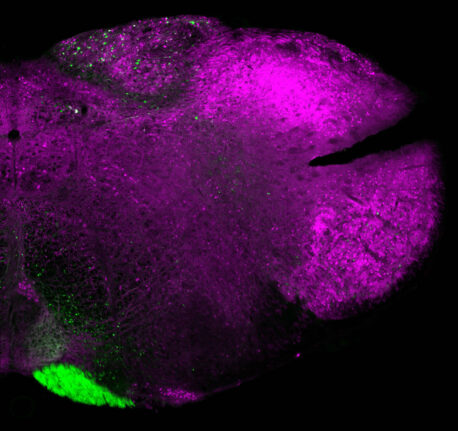
September 23, 2025
Salk scientists use mouse model to pinpoint gracile nucleus as brain area responsible for discriminating between painful and non-painful touch, with its dysfunction leading to chronic pain
Salk scientists use mouse model to pinpoint gracile nucleus as brain area responsible for discriminating between painful and non-painful touch, with its dysfunction leading to chronic pain
LA JOLLA—After nine months in the womb, humans enter a world filled with texture and shape. We must then quickly learn to recognize and respond to textures and objects in the outside world, beginning with sensations like the soft feel of a t-shirt or the doughy squish of a sandwich. By learning what touch sensations are innocuous, the brain can better recognize painful insults that might cause damage—think skinning a knee or stubbing a toe. But 7 to 10 percent of the global population develops mechanical allodynia, a form of chronic pain where innocuous light touch is perceived as painful.
Salk Institute neuroscientists have discovered that altered neuronal activity in a brain area called the dorsal column nuclei drives mechanical allodynia. The dorsal column nuclei process and categorize light touch information before sending it on to cortical areas that discriminate between different types of touch. In monitoring the activity of mouse neurons in the gracile nucleus, they discovered that mechanical allodynia causes the gracile nucleus’ normal neural activity patterns to become uncoordinated. Because of this, the brain no longer recognizes light touch as being innocuous and instead interprets it as being painful. In an act of self-preservation, the brain then initiates a pain-like response—better to be safe than sorry.

The findings, published in Cell Reports on September 23, 2025, show that uncoordinated gracile nuclei neural activity patterns cause mechanical allodynia—not a simple increase in activity as previously assumed. This new understanding of how the brain processes and encodes pain is a crucial first step toward designing acute and chronic pain therapeutics.
“We’ve determined where the body discriminates between painful and non-painful touch, and it’s much further upstream than what was once thought,” says senior author Martyn Goulding, PhD, a professor and holder of the Frederick W. and Joanna J. Mitchell Chair at Salk. “What’s especially interesting to me is that we’ve shown it’s the very nature of a sensation that determines whether it is painful or not painful, rather than pain and non-pain existing on a sliding scale where crossing a certain threshold is all it takes to turn something from innocuous to painful.”
What we know about how the brain processes touch and pain
Pain is first and foremost a protective response. A rock sneaks into your sandal, and you take an unsuspecting step—ouch! Instinctively, you hop onto your other foot to take your weight off the rock and alleviate the discomfort. In that instant, your brain can quickly differentiate the expected feeling of soft shoe and the unexpected feeling of pointy rock.
This is possible thanks to extensive training to differentiate objects that cause injury from those that do not—discrimination that happens in dorsal column nuclei, comprising the cuneate nucleus and gracile nucleus, that sit at the junction between the upper spine and brainstem. The neurons in the cuneate and gracile nuclei fire in patterns, with this firing pattern forming a representation of the tactile experience that can be understood by the rest of the brain.

The dorsal column nuclei’s representation of touch gets transmitted to another area called the thalamus, which also plays a prominent role in pain perception. However, this is mediated by different thalamic regions that receive noxious pain information from specialized pain receptors termed nociceptors. Normally, these two pathways remain separated, but in the case of mechanical allodynia, it seems that their wires get crossed at the level of the thalamus and above, in the cortex. Understanding how these wires get crossed is the next step in determining how the brain distinguishes innocuous from painful touch.
Setting up a model to understand mechanical allodynia
Recent findings have pointed to a relationship between the dorsal column nuclei and mechanical allodynia, but the specifics have remained elusive. The Salk team set out to understand the specifics of the dorsal column nuclei’s role, testing the prevailing idea that a simple increase in neural activity results in the transformation of “innocuous” to “painful” touch signaling. Parsing out the details meant comparing mouse models with and without mechanical allodynia.
“By looking at both inflammation-induced and injury-induced mechanical allodynia, we were able to search for common signatures in the patterns of neural activity that characterize this form of chronic pain,” says co-first author Amandine Virlogeux, a postdoctoral researcher in Goulding’s lab. “This led us to observe changes in neural processing that point to the dorsal column nuclei as crucial in discriminating innocuous touch from potentially harmful touch.”
The findings demonstrate that mechanical allodynia is not due to a simple increase in activity within the dorsal column nuclei. Rather, mechanical allodynia emerges when dorsal column nuclei lose the ability to properly encode new information and, in turn, set the touch default to painful.
“Injury or inflammation distort the neural activity patterns that normally encode innocuous touch in the dorsal column nuclei,” explains co-first author Tejapratap Bollu, a postdoctoral researcher in Goulding’s lab. “These altered signals no longer match the representations in the brain and, as a result, the brain perceives these innocuous stimuli as painful.”
The future of pain research and road to therapeutics
Discovering that the gracile nucleus is altering the representations of touch stimuli is an enormous step for neuroscientists working to understand mechanical allodynia and how to treat it. Current treatments for allodynia range from antidepressants to topical ointments. Pinpointing the dorsal column nuclei as foundational in the expression of mechanical allodynia is a critical insight that researchers can use to develop more specific, effective medications.
Other authors include Xiangyu Ren and Ana Palma of Salk.
The work was supported by the National Institutes of Health (R35NS111643, NCI CCSG: P30 CA01495, NINDS R24 Core Grant, NEI), George E. Hewitt Foundation, and Helen Hay Whitney Foundation.
DOI: 10.1016/j.celrep.2025.116248
JOURNAL
Cell Reports
AUTHORS
Amandine Virlogeux, Tejapratap Bollu, Xiangyu Ren, Ana Palma, Martyn Goulding
Office of Communications
Tel: (858) 453-4100
press@salk.edu
Unlocking the secrets of life itself is the driving force behind the Salk Institute. Our team of world-class, award-winning scientists pushes the boundaries of knowledge in areas such as neuroscience, cancer research, aging, immunobiology, plant biology, computational biology and more. Founded by Jonas Salk, developer of the first safe and effective polio vaccine, the Institute is an independent, nonprofit research organization and architectural landmark: small by choice, intimate by nature, and fearless in the face of any challenge.